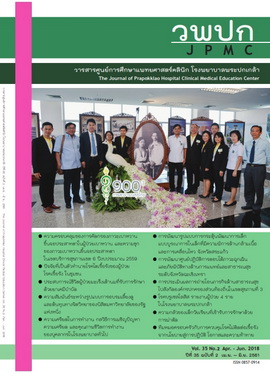Model Development for Integrated Stimulate Program for Children’s Development in Children with Muscular and Movement Disabilities, Sa Kaeo Province.
Main Article Content
Abstract
Background: The report of childhood developmental screening of Sa Kaeo Province in 2017 showed that there is 6.53 percent of suspected developmental delay in children and needed developmental stimulation. Among those were disabled children. Wang Nam Yen Hospital, Sa Kaeo Province, has developed an innovative integrated program to stimulate these disabled children. Therefore, it has planned to compile all relevant proven knowledge to develop a stimulate model for disabled children, especially muscle and movement disability.
Objective: To develop an innovative integrated stimulate program for disabled children in muscle and movement development in Sa Kaeo Province.
Materials and methods: The research and development method was used to develop the integrated stimulate program in children who have disability in muscle and movement in Sra-Kaeo Province and to include the participation of nurses, Thai Traditional Medicine, child carer in child development center and parents. The study has 4 phases: 1) identify problems and obstacles in disabled children stimulation, 2) set up an innovative integrated program to stimulate children with muscle and movement disability through cooperation of parents, hospital, child development center and school, 3) deploy "I SMART PARI. Model" which the researcher has created, and 4) evaluation.
Results: After applying "I SMART PARI. Model", majority of the disabled children have improvement in their development in all aspect, and the satisfaction of parents has significantly increased (P<0.001).
Conclusion Development stimulation for disabled children requires cooperation and integration of related personnel. This will help disabled children’s better development and able to take care of themselves in daily activity.
Keywords: model; development; stimulate, children; disabilities; mobility
Article Details
References
2. Ratanarojsakul P. Learning and creating of knowledge of community and family of disabled children. Journal of Education: Faculty of Education, Srinakharinwirot University 2008; 16(2): 15-27.
3. Sra-kaeo Province health office. Annual cumulative data of child development promotion program with disabilities, Srakaeo; Department of health promotion; 2017.
4. Sukbunpant S. The Integrating of local wisdom to support the development of children with disability by parent involvement at Sansai district Chiangmai province. Chiangmai: Faculty of Education,Chiang Mai Rajabhat University; 2015.
5. The Fellowship Foundation for Child and Youth Development. The FCYD strategy 2015-2017. Nong Khai: The Fellowship Foundation; 2017.
6. Blair C, Diamond A. Biological processes in prevention and intervention: the promotion of self-regulation as a means of preventing school failure. Deve Psychopathol 2008; 20: 899-911.
7. Chotchuangnirau N. The development and integration nurture for delayed developmental child. Srinagarind Medical Journal, Faculty of Medicine, Khon Kaen University 2009; 24: 106-11.

